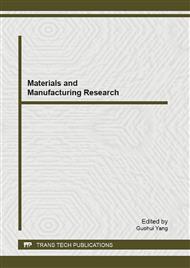p.50
p.56
p.61
p.67
p.73
p.80
p.85
p.89
p.93
Study on Corrosion Resistance and Cytotoxicity of the Fluoropolymer Thin Films on Titanium Alloy Surface
Abstract:
The objective was to investigate the corrosion resistance performance of Ti-6Al-4V alloy surface containing fluorine polymer film and polymer film to cell toxicity. Be evaluating the application prospect in modified method of medical titanium alloy. Using spin coating technique and thermal cross-linking method to prepare fluorine polymer film on Ti-6Al-4V alloy surface, and then characterized by XPS and surface contact angle. By electrochemical corrosion method and the cytotoxicity experiment were to evaluate corrosion resistance and cytotoxicity of the fluorine polymer film. The results show the XPS of the experimental group were stronger spectrum peaks of element C, F; but the spectrum peaks of element Ti, Al were not observed, the surface contact angle in experimental group increased from 57.7° to 97.1°, compared with the control group. The results of electrochemical corrosion experiment showed that the corrosion potential increased from -0.82 V to -0.062 V, and the corrosion current density of the experimental group reduced from 1.301 × 10-5 A • cm-2 to 1.939 × 10-7 A • cm-2, compared with Ti-6Al-4V alloy. Meanwhile the cytotoxicity test showed that RGR values of the experimental group were greater than 90% at different time points, and RGR values were higher than 100% at 2 and 4 days. In conclusion, the Ti-6Al-4V alloy surface with the preparation of fluorine polymer film has better corrosion resistance and no cell toxicity. It has well prospect in clinical application.
Info:
Periodical:
Pages:
73-79
Citation:
Online since:
January 2013
Authors:
Price:
Сopyright:
© 2013 Trans Tech Publications Ltd. All Rights Reserved
Share:
Citation:


